There are many different types of owls found in West Virginia. Some, like the great horned owl, are very common and easily recognizable. Others, like the saw-whet owl, are much more difficult to spot. In this blog post, we will discuss the various types of owls that can be found in our state. We will also provide some tips for spotting these elusive creatures!
We’ll show you the state’s most prevalent owls with photos and important facts. The data were gathered from trusted sources and verified by an ornithologist.
Most Common Owls of WV
The most common owls in West Virginia are the great horned owl, the barn owl, and the screech owl.
Great Horned Owl
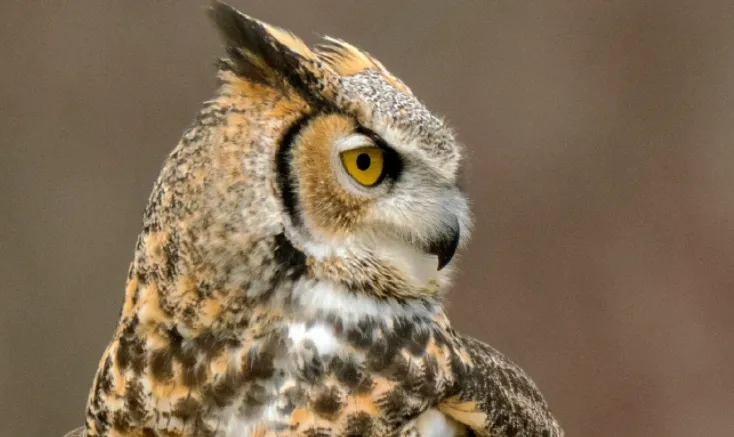
Great Horned Owl Length: 18.1-24.8 in
The great horned owl is one of the most easily recognizable owls. They are large birds with wingspan of up to five feet. They have prominent ear tufts, which are actually feathers, and yellow eyes. Great horned owls are found in many different habitats, including forests, swamps, and even urban areas. In West Virginia, they are most commonly found in wooded areas.
Great horned owls are predators and will eat just about anything they can catch. Their diet includes small mammals, reptiles, birds, and even fish. They have been known to kill animals much larger than themselves, including deer. Great horned owls are very powerful hunters and use their sharp talons to kill their prey.

Barn Owl
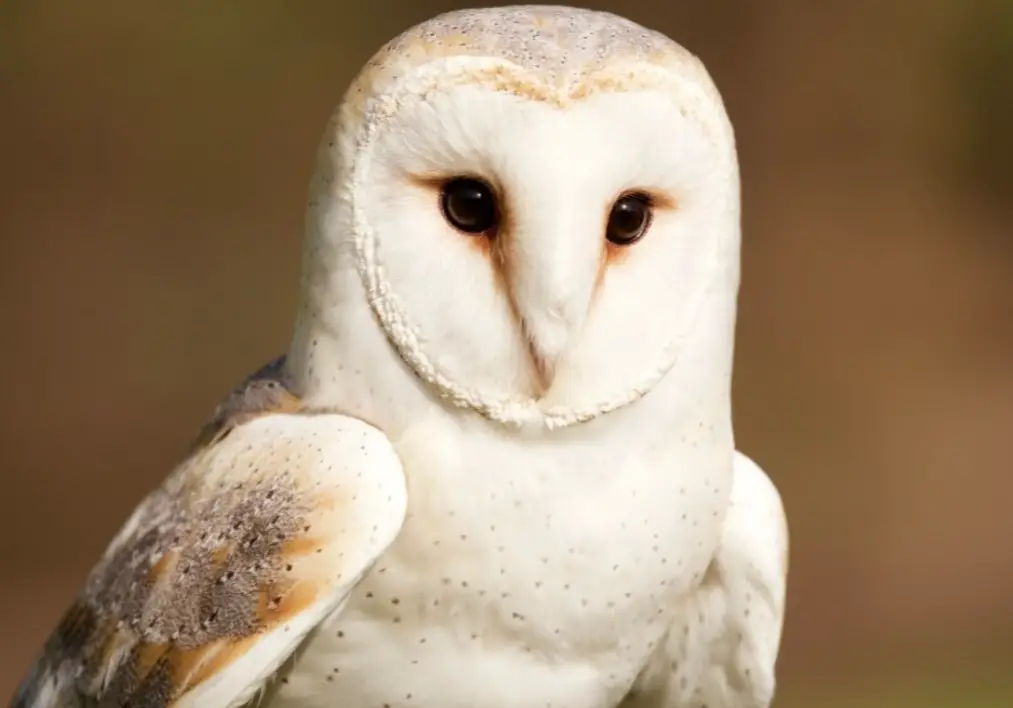
Barn Owl Length: 12.6-15.8 in
The barn owl is a medium-sized owl with a wingspan of up to four feet. They have a white or pale gray face and body with dark brown streaks. Barn owls are found in open areas, such as farmland and prairies. They feed on small mammals, such as rodents, rabbits, and bats.
In West Virginia, barn owls are most commonly found in the eastern and western parts of the state. They can also be found in some of the southern counties. The best time to see a barn owl is at dawn or dusk. If you are lucky enough to see one, you will likely hear its distinctive call first. Barn owls are shy birds and are not often seen. If you do see one, please enjoy the moment and be sure to take a picture!

Snowy Owl
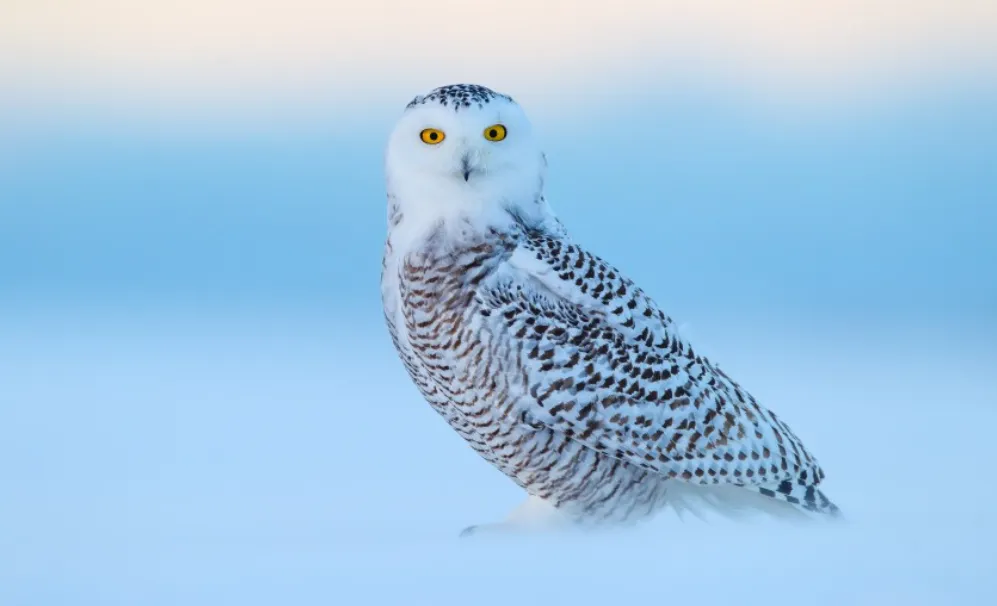
Snowy Owl Length: 20.5-27.9 in
The Snowy Owl is one of the most distinctive birds in North America. They are easily recognizable by their white plumage, which makes them perfect for camouflage when hunting in the snow.
Snowy Owls are typically found in Arctic tundra and prairies, but they have been known to wander south in search of food. Recently, a Snowy Owl was spotted in West Virginia, providing a rare opportunity for birders in the eastern United States.
Snowy Owls are ferocious hunters and can take down prey as large as geese and rabbits. They typically eat small mammals, birds, and fish, but will also consume carrion (dead animal flesh).
The Snowy Owl is a diurnal bird, meaning that it hunts during the day. It is a solitary species and typically mates for life.
Snowy Owls are considered to be fairly tame birds and can often be seen perched on fence posts or other high places. If you’re lucky enough to see one, be sure to enjoy the moment and appreciate this beautiful creature!

Barred Owl
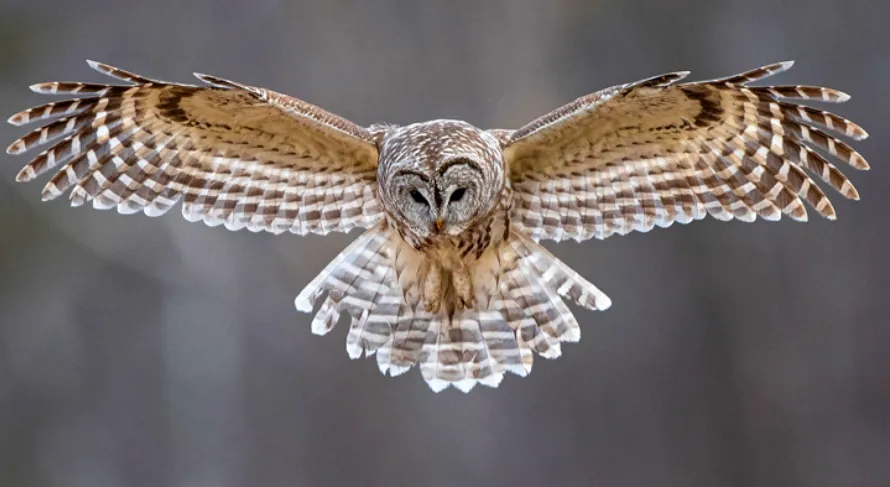
Barred Owl Length: 16.9-19.7 in
The Barred Owl is one of the most common owl species in North America. They are found in a variety of habitats, including forests, wetlands, and even urban areas.
Barred Owls have brown plumage with white stripes running down their chests. They are named for the barred markings on their wings, which help to camouflage them in the trees.
Barred Owls are nocturnal birds, meaning that they hunt at night. They are proficient hunters and can take down prey as large as squirrels and rabbits.
Barred Owls typically mate for life and often nest in the same area year after year. If you’re lucky enough to see one, be sure to listen for their characteristic hoot!

Northern Hawk Owl
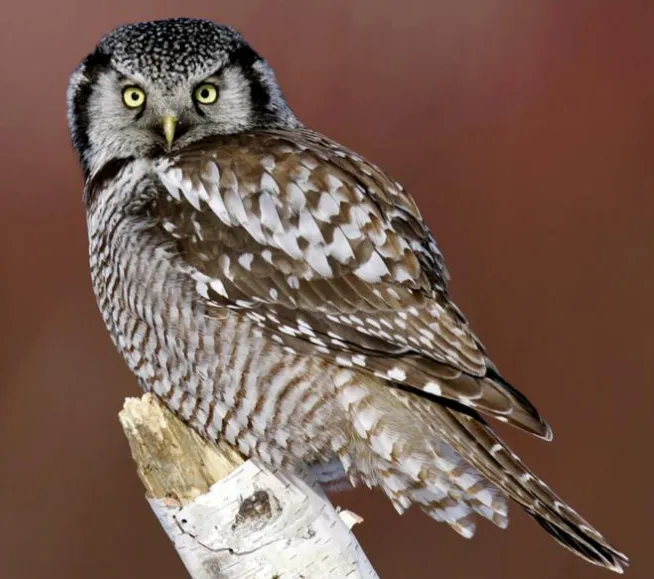
The Northern Hawk Owl is a medium-sized owl with a round head, yellow eyes, and a hooked bill. It has long wings and a short tail. The upper parts are dark brown barred with white, while the underparts are light buff to whitish with numerous small black spots. The feet are feathered to the toes.
This owl is found in open coniferous forests in the northern boreal regions of North America. It breeds from Alaska and Northern Canada south to Colorado and Virginia, but most hawk owls in the contiguous United States are found in Minnesota. In winter, this owl may be seen as far south as Florida and central Texas.
The Northern Hawk Owl is a diurnal owl, meaning it is active during the day. It feeds mainly on small rodents such as mice and voles but also takes birds, reptiles, and amphibians. This owl nests in an old hawk or crow nest, laying up to six eggs.
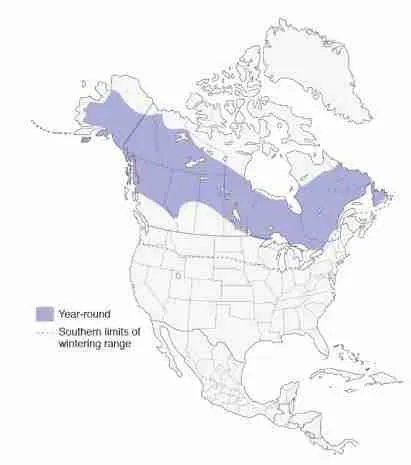
Long-eared Owl
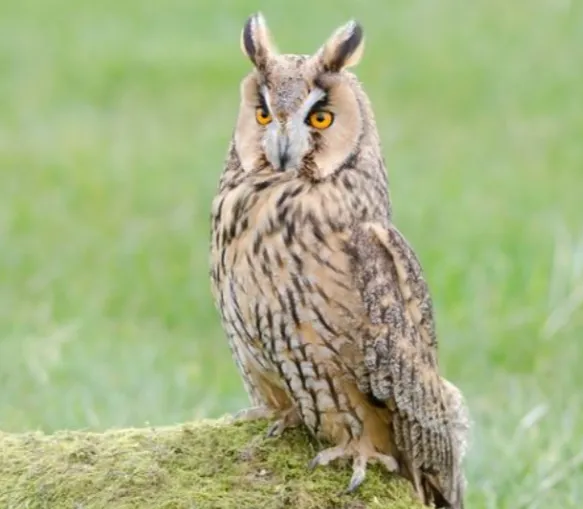
The Long-eared Owl is a medium-sized owl that is found in wooded areas throughout the eastern United States. This owl is easily identified by its long, pointed ears. The Long-eared Owl feeds primarily on small rodents such as mice and voles. This owl can be difficult to see because it tends to stay hidden in dense foliage. However, the Long-eared Owl can be heard calling throughout the night, especially during the breeding season.
The Long-eared Owls are relatively common owls in West Virginia. This owl can be found in wooded areas throughout the state. The Long-eared Owl feeds primarily on small rodents such as mice and voles. This owl can be difficult to see because it tends to stay hidden in dense foliage. However, the Long-eared Owl can be heard calling throughout the night, especially during the breeding season.
Related article: Types of Owls in Nebraska

Northern Saw-Whet Owl
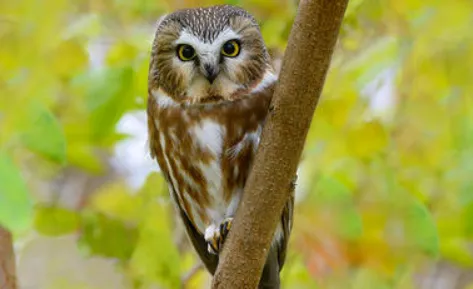
The Northern Saw-Whet Owl is a small owl. Adults are about seven inches long and have a wingspan of about 15 inches.
Females and males look similar, with brownish-gray upperparts, white underparts, and yellow eyes. These owls get their name from their call, which sounds like a saw being sharpened on a whetstone.
Northern Saw-Whet Owls are found in forests across North America. In the summer, they live in northern forests, and in the winter they move south to mid-latitude forests. Some Northern Saw-Whet Owls even migrate to Mexico and Central America.
These owls are mostly nocturnal, but they can also be active during the day. They eat small mammals, like mice, rats, and voles, as well as birds and insects. Northern Saw-Whet Owls build their nests in trees or other tall structures. The female lays four to six eggs, and the chicks hatch about a month later.
Northern Saw-Whet Owls are common owls and are not considered threatened or endangered. However, they can be affected by habitat loss and fragmentation. They are also sometimes killed by cars when crossing roads.

Eastern Screech Owl
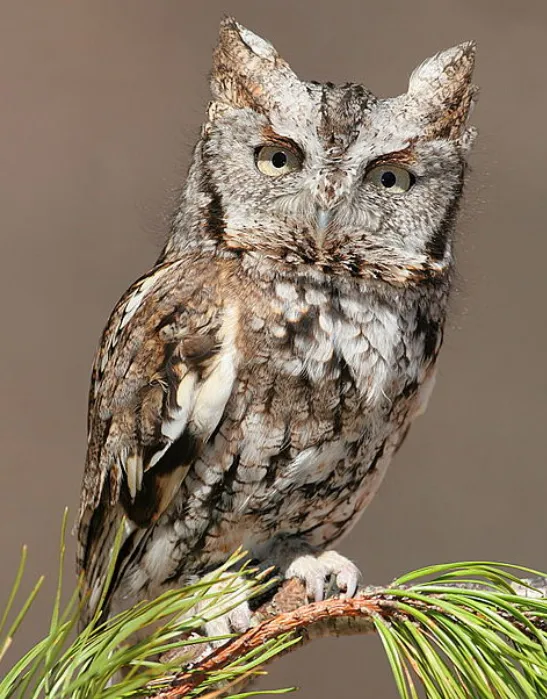
Eastern Screech Owl Length: 6.3-9.8 in
The Eastern Screech Owl is a small owl that is found in wooded areas throughout the eastern United States. This owl is easily identified by its large, round eyes and “ear” tufts. The Eastern Screech Owl feeds primarily on insects, but it will also eat small mammals, like mice and rats.
Eastern Screech Owls are common owls and are not considered threatened or endangered. However, they can be affected by habitat loss and fragmentation. They are also sometimes killed by cars when crossing roads.
Eastern Screech Owls typically nest in tree cavities, but they will also use old nests made by other birds or animals. The female lays two to six eggs, and the chicks hatch about a month later.
The Eastern Screech Owl is a small owl that is found in wooded areas throughout the eastern United States. This owl is easily identified by its large, round eyes and “ear” tufts. The Eastern Screech Owl feeds primarily on insects, but it will also eat small mammals, like mice and rats.
Eastern Screech Owls are common owls and are not considered threatened or endangered. However, they can be affected by habitat loss and fragmentation. They are also sometimes killed by cars when crossing roads.

How many owls are in West Virginia?
According to the West Virginia Department of Natural Resources, there are nine different species of owls in the state. The most common owl in West Virginia is the Barred Owl, which can be found in forests throughout the state. Other common owls include the Great Horned Owl, the Eastern Screech-Owl, and the Northern Saw-whet Owl. Owls are most active at night, so if you’re hoping to spot one, your best bet is to go out after sunset. Keep your eyes peeled and your ears open, and you just might see or hear some owls in West Virginia!
Are owls good to have around your house?
There is no definitive answer to this question as owls can provide different benefits depending on the species and situation. Generally speaking, however, owls can be beneficial in a few ways. For one, their keen eyesight and hearing make them great at catching prey, which can help reduce the number of rodents or other pests around your home.
Additionally, owls are typically nocturnal creatures, so their presence can help deter burglars or other intruders who are active at night. Finally, some people simply enjoy the beauty and mystery of these fascinating animals and having an owl nearby can be a real treat.

An avid ornithologist, zoologist and biologist with an unwavering passion for birds and wild animals.
Dr. Wilson’s journey in ornithology began in childhood and led him to obtain a Ph.D. in Ornithology from the prestigious Avian Research Institute. He has worked closely with renowned experts in the field and conducted extensive research and field studies globally.

